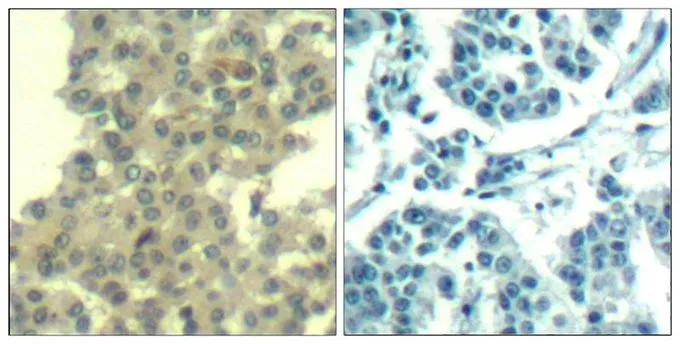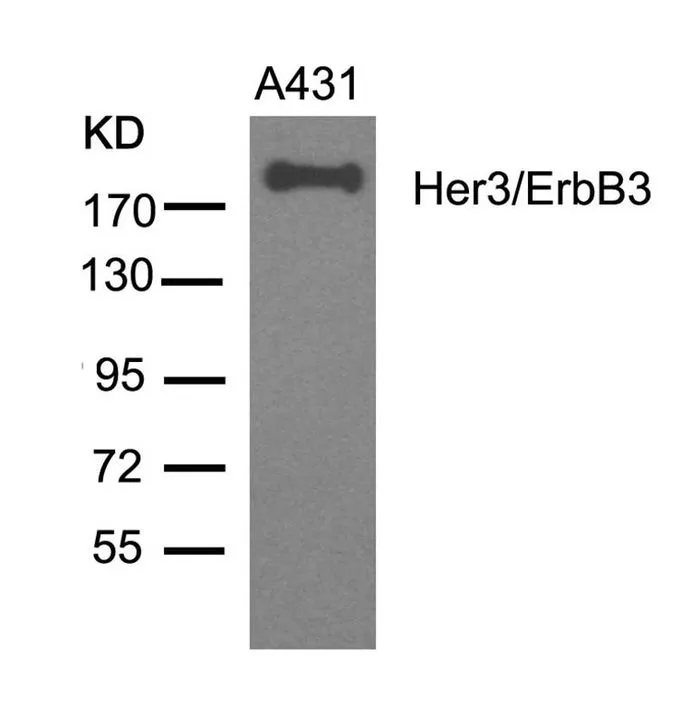
IHC-P analysis of human breast carcinoma tissue using GTX50651 Her3 / ErbB3 antibody. Left : Primary antibody Right : Primary antibody pre-incubated with the antigen specific peptide
Her3 / ErbB3 antibody
GTX50651
ApplicationsWestern Blot, ImmunoHistoChemistry, ImmunoHistoChemistry Paraffin
Product group Antibodies
ReactivityHuman
TargetERBB3
Overview
- SupplierGeneTex
- Product NameHer3 / ErbB3 antibody
- Delivery Days Customer9
- Application Supplier NoteWB: 1:500-1:1000. IHC-P: 1:50-1:100. *Optimal dilutions/concentrations should be determined by the researcher.Not tested in other applications.
- ApplicationsWestern Blot, ImmunoHistoChemistry, ImmunoHistoChemistry Paraffin
- CertificationResearch Use Only
- ClonalityPolyclonal
- Concentration1 mg/ml
- ConjugateUnconjugated
- Gene ID2065
- Target nameERBB3
- Target descriptionerb-b2 receptor tyrosine kinase 3
- Target synonymsc-erbB3; c-erbB-3; ErbB-3; erbB3-S; FERLK; HER3; human epidermal growth factor receptor 3; LCCS2; MDA-BF-1; p180-ErbB3; p45-sErbB3; p85-sErbB3; proto-oncogene-like protein c-ErbB-3; receptor tyrosine-protein kinase erbB-3; tyrosine kinase-type cell surface receptor HER3; v-erb-b2 avian erythroblastic leukemia viral oncogene homolog 3; VSCN1
- HostRabbit
- IsotypeIgG
- Protein IDP21860
- Protein NameReceptor tyrosine-protein kinase erbB-3
- Scientific DescriptionThis gene encodes a member of the epidermal growth factor receptor (EGFR) family of receptor tyrosine kinases. This membrane-bound protein has a neuregulin binding domain but not an active kinase domain. It therefore can bind this ligand but not convey the signal into the cell through protein phosphorylation. However, it does form heterodimers with other EGF receptor family members which do have kinase activity. Heterodimerization leads to the activation of pathways which lead to cell proliferation or differentiation. Amplification of this gene and/or overexpression of its protein have been reported in numerous cancers, including prostate, bladder, and breast tumors. Alternate transcriptional splice variants encoding different isoforms have been characterized. One isoform lacks the intermembrane region and is secreted outside the cell. This form acts to modulate the activity of the membrane-bound form. Additional splice variants have also been reported, but they have not been thoroughly characterized. [provided by RefSeq, Jul 2008]
- ReactivityHuman
- Storage Instruction-20°C or -80°C,2°C to 8°C
- UNSPSC12352203
References
- Piperlongumine downregulates the expression of HER family in breast cancer cells. Jin HO et al., 2017 May 13, Biochem Biophys Res CommunRead more

